Ion Accelerator Facility of the Wakasa Wan Energy Research Center for the Study of Irradiation Effects on Space Electronics
Abstract
1. Introduction
2. Overview of Ion Accelerators at WERC
2.1. Tandem Accelerator at WERC
2.2. Synchrotron
2.3. Ion-Implanter
3. Beamlines and Irradiation Apparatuses for the Research on Irradiation Effects on Space Electronics
3.1. Beamline of the Synchrotron in Irradiation Room 4
3.2. Beamline of the Tandem Accelerator in Irradiation Room 2
3.3. Beamline of the 200 kV Ion-Implanter in Irradiation Room 1
4. Recent Results of Ion Irradiation Effects on Space Electronics at WERC
4.1. Recent Experiments Using Accelerators at WERC
4.2. Research Results Using the Synchrotron
4.3. Research Results Using the Tandem Accelerator and the Synchrotron
4.4. Research Results Using the Tandem Accelerator
4.5. Research Results Using the Ion-Implanter
5. Summary
Author Contributions
Funding
Data Availability Statement
Acknowledgments
Conflicts of Interest
References
- Hatori, S.; Kurita, T.; Hayashi, Y.; Yamada, M.; Yamada, H.; Mori, J.; Hamachi, H.; Kimura, S.; Shimoda, T.; Hiroto, M.; et al. Developments and applications of accelerator system at the Wasasa Wan Energy Research Center. Nucl. Instrum. Methods B 2005, 241, 862–869. [Google Scholar] [CrossRef]
- Hatori, S.; Fukumoto, S.; Hayashi, Y.; Kagawa, H.; Kurita, T.; Minehara, E.J.; Nagasaki, S.; Nakata, Y.; Odagiri, T.; Shimada, M.; et al. Tandem accelerator as an injector for the medical-use synchrotron at the wakasa wan energy research center. In Proceedings of the 1st International Particle Accelerator Conference, Kyoto, Japan, 23–28 May 2010; pp. 714–716. [Google Scholar]
- Fujinaga, H.; Sakai, Y.; Yamashita, T.; Arai, K.; Terashima, T.; Komura, T.; Seki, A.; Kawaguchi, K.; Nasti, A.; Yoshida, K.; et al. Biological characteristics of gene expression features in pancreatic cancer cells induced by proton and X-ray irradiation. Int. J. Radiat. Biol. 2019, 95, 571–579. [Google Scholar] [CrossRef]
- Lin, C.; Kume, K.; Mori, T.; Martinez, M.E.; Okazawa, H.; Kiyono, Y. Predictive Value of Early-Stage Uptake of 3’-Deoxy-3’-18F-Fluorothymidine in Cancer Cells Treated with Charged Particle Irradiation. J. Nucl. Med. 2015, 56, 945–950. [Google Scholar] [CrossRef]
- Das, S.K.; Masuda, M.; Hatashita, M.; Sakurai, A.; Sakakibara, M. Optimization of culture medium for cordycepin production using Cordyceps militaris mutant obtained by ion beam irradiation. Process Biochem. 2010, 45, 129–132. [Google Scholar] [CrossRef]
- Takagi, K.; Tsukada, T.; Izumi, M.; Kazama, K.; Hayashi, Y.; Abe, T. Localization of γH2AX Fluorescence along Tracks of Argon Beams. RIKEN Accel. Prog. Rep. 2010, 43, vii–viii. [Google Scholar]
- Hatashita, M.; Takagi, K.; Ichida, H.; Abe, T. Effect of ion-beam irradiation on mycelial growth of medicinal mushrooms. RIKEN Accel. Prog. Rep. 2019, 53, 200. [Google Scholar]
- Ito, Y.; Yamauchi, T.; Yamamoto, A.; Sasase, M.; Nishio, S.; Yasuda, K.; Ishigami, R. Ion beam synthesis of 3C-SiC layers in Si and its application in buffer layer for GaN epitaxial growth. Appl. Surf. Sci. 2004, 238, 159–164. [Google Scholar] [CrossRef]
- Ishigami, R.; Batchuluun, C.; Yasuda, K. Increase in coercivity of Fe-Pt thin film permanent magnets by N2+ ion implantation and heat treatment in hydrogen gas. Nucl. Instrum. Methods B 2012, 275, 58–62. [Google Scholar] [CrossRef]
- Iwase, A.; Yoneda, K.; Ishigami, R.; Matsui, T. Restoration of ion beam irradiation induced metastable magnetic states and lattice structures of FeRh thin films by heat treatments at elevated temperatures. J. Magn. Magn. Mater. 2020, 515, 167286. [Google Scholar] [CrossRef]
- Yasuda, K.; Kajitori, Y.; Oishi, M.; Nakamura, H.; Haruyama, Y.; Saito, M.; Suzuki, K.; Ishigami, R.; Hibi, S. Upgrades of a time-of-fight elastic recoil detection analysis measurement system for thin flm analysis. Nucl. Instrum. Methods B 2019, 442, 53–58. [Google Scholar] [CrossRef]
- Suzuki, K.; Nakata, Y. Development of an in-air ERDA system for hydrogen analysis. Nucl. Instrum. Methods B 2019, 450, 135–138. [Google Scholar] [CrossRef]
- Suzuki, K.; Tsuchiya, B.; Yasuda, K.; Nakata, Y. Light element analysis of ceramics using in-air ERDA and TOF-ERDA. Nucl. Instrum. Methods B 2020, 478, 169–173. [Google Scholar] [CrossRef]
- Fukumoto, K.; Tone, K.; Onitsuka, T.; Ishigami, R. Effect of Ti addition on microstructural evolution of V–Cr–Ti alloys to balance irradiation hardening with swelling suppression. Nucl. Mater. Energy 2018, 15, 122–127. [Google Scholar] [CrossRef]
- Das, A.K.; Ishigami, R.; Kamal, I. Proton implantation effect on SUS-316 stainless steel. J. Alloys Compd. 2015, 629, 319–321. [Google Scholar] [CrossRef]
- Fukumoto, K.; Kitamura, Y.; Miura, S.; Fujita, K.; Ishigami, R.; Nagasaka, T. Irradiation Hardening Behavior of He-Irradiated V-Cr-Ti Alloys with Low Ti Addition. Quantum Beam Sci. 2021, 5, 1. [Google Scholar] [CrossRef]
- Ogino, N.; Arimoto, M.; Sawano, T.; Yonetoku, D.; Yu, P.; Watanabe, S.; Hiraga, J.S.; Yuhi, D.; Hatori, S.; Kume, K. Performance verification of next-generation Si CMOS soft X-ray detector for space applications. Nucl. Instrum. Methods A 2021, 987, 164843. [Google Scholar] [CrossRef]
- Hirade, N.; Takahashi, H.; Uchida, N.; Ohno, M.; Torigoe, K.; Fukazawa, Y.; Mizuno, T.; Matake, H.; Hirose, K.; Hisadomi, S.; et al. Annealing of proton radiation damages in Si-PM at room temperature. Nucl. Instrum. Methods A 2021, 986, 164673. [Google Scholar] [CrossRef]
- Arimoto, M.; Harita, S.; Sugita, S.; Yatsu, Y.; Kawai, N.; Ikeda, H.; Tomida, H.; Isobe, N.; Ueno, S.; Mihara, T.; et al. Development of a 32-channel ASIC for an X-ray APD detector onboard the ISS. Nucl. Instrum. Methods A 2018, 882, 138–147. [Google Scholar] [CrossRef]
- Okuyama, K.; (Hitachi Ltd., Ibaraki-ken, Japan). Personal communication, 2021.
- Mizushima, T.; Yoshida, A.; Yamaoka, K.; Hatori, S.; Kume, K. Study on possible protpn-induced background of LaBr3(Ce) scintillator in a low-earth orbit. Proc. SPIE 2020, 11454, 114542S. [Google Scholar]
- Sasaki, H.; Hisaka, T.; Kadoiwa, K.; Kamo, Y.; Ishimura, E.; Hatori, S.; Ishigami, R.; Kume, K. Reliability Study of Proton Irradiation Effects on AlGaN/GaN HEMTs. In Proceedings of the 34th Annual Reliability of Compound Semiconductors (ROCS) Workshop, Minneapolis, MN, USA, 29 April 2019; pp. 83–86. [Google Scholar]
- Ozaki, M.; (Kobe University, Kobe, Japan). Personal communication, 2021.
- Kanaya, S.; Kim, G.M.; Ikegami, M.; Miyasaka, T.; Suzuki, K.; Miyazawa, Y.; Toyota, H.; Osonoe, K.; Yamamoto, T.; Hirose, K. Proton Irradiation Tolerance of High-Efficiency Perovskite Absorbers for Space Applications. J. Phys. Chem. Lett. 2019, 10, 6990–6995. [Google Scholar] [CrossRef]
- Imaizumi, M.; Ohshima, T.; Yuri, Y.; Suzuki, K.; Ito, Y. Effects of beam conditions for ground irradiation tests on degradation of photovoltaic characteristics of space solar cells. Quantum Beam Sci. 2021; to be published. [Google Scholar]
- Ferlet-Cavros, V.; Massengill, L.W.; Gouker, P. Single Event Transients in Digital CMOS—A Review. IEEE Trans. Nucl. Sci. 2013, 60, 1767–1790. [Google Scholar] [CrossRef]
- Srour, J.R.; Palko, J.W. Displacement Damage Effects in Irradiated Semiconductor Devices. IEEE Trans. Nucl. Sci. 2013, 60, 1740–1766. [Google Scholar] [CrossRef]
- Makino, T.; Onoda, S.; Ohshima, T.; Kobayashi, D.; Ikeda, H.; Hirose, K. A Methodology for Reconstructing DSET Pulses from Heavy-Ion Broad-Beam Measurement. Quantum Beam Sci. 2020, 4, 15. [Google Scholar] [CrossRef]
- Kobayashi, D.; Hirose, K.; Sakamoto, K.; Okamoto, S.; Baba, S.; Shindou, H.; Kawasaki, O.; Makino, T.; Ohshima, T.; Mori, Y.; et al. Data-Retention-Voltage-Based Analysis of Systematic Variations in SRAM SEU Hardness: A Possible Solution to Synergistic Effects of TID. IEEE Trans. Nucl. Sci. 2020, 67, 328–335. [Google Scholar] [CrossRef]
- Imaizumi, M.; Nakamura, T.; Takamoto, T.; Ohshima, T.; Tajima, M. Radiation degradation characteristics of component subcells in inverted metamorphic triple-junction solar cells irradiated with electrons and protons. Prog. Photovolt. Res. Appl. 2017, 25, 161–174. [Google Scholar] [CrossRef]
- Hoeffgen, S.K.; Metzger, S.; Steffens, M. Investigating the Effects of Cosmic Rays on Space Electronics. Front. Phys. 2020, 8, 318. [Google Scholar] [CrossRef]
- Yonetoku, D.; Mihara, T.; Sawano, T.; Ikeda, H.; Harayama, A.; Takata, S.; Yoshida, K.; Seta, H.; Toyanago, A.; Kagawa, Y.; et al. High-z gamma-ray bursts for unraveling the dark ages mission HiZ-GUNDAM. Proc. SPIE 2014, 9144, 15–26. [Google Scholar]
- Nakauchi, Y.; Abe, M.; Ohtake, M.; Matsumoto, T.; Tsuchiyama, A.; Kitazato, K.; Yasuda, K.; Suzuki, K.; Nakata, Y. The formation of H2O and Si-OH by H2+ irradiation in major minerals of carbonaceous chondrites. Icarus 2021, 355, 114140. [Google Scholar] [CrossRef]
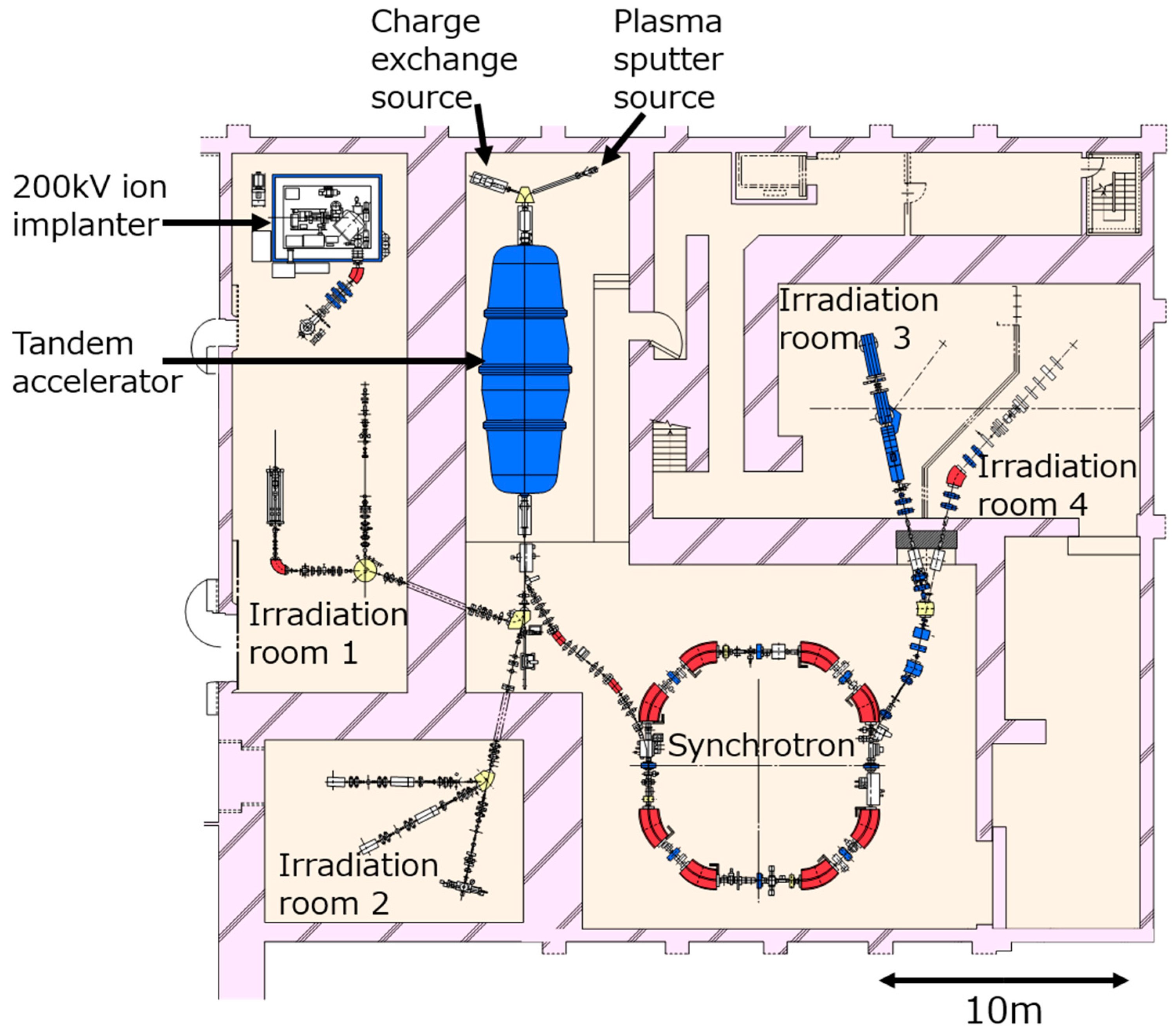
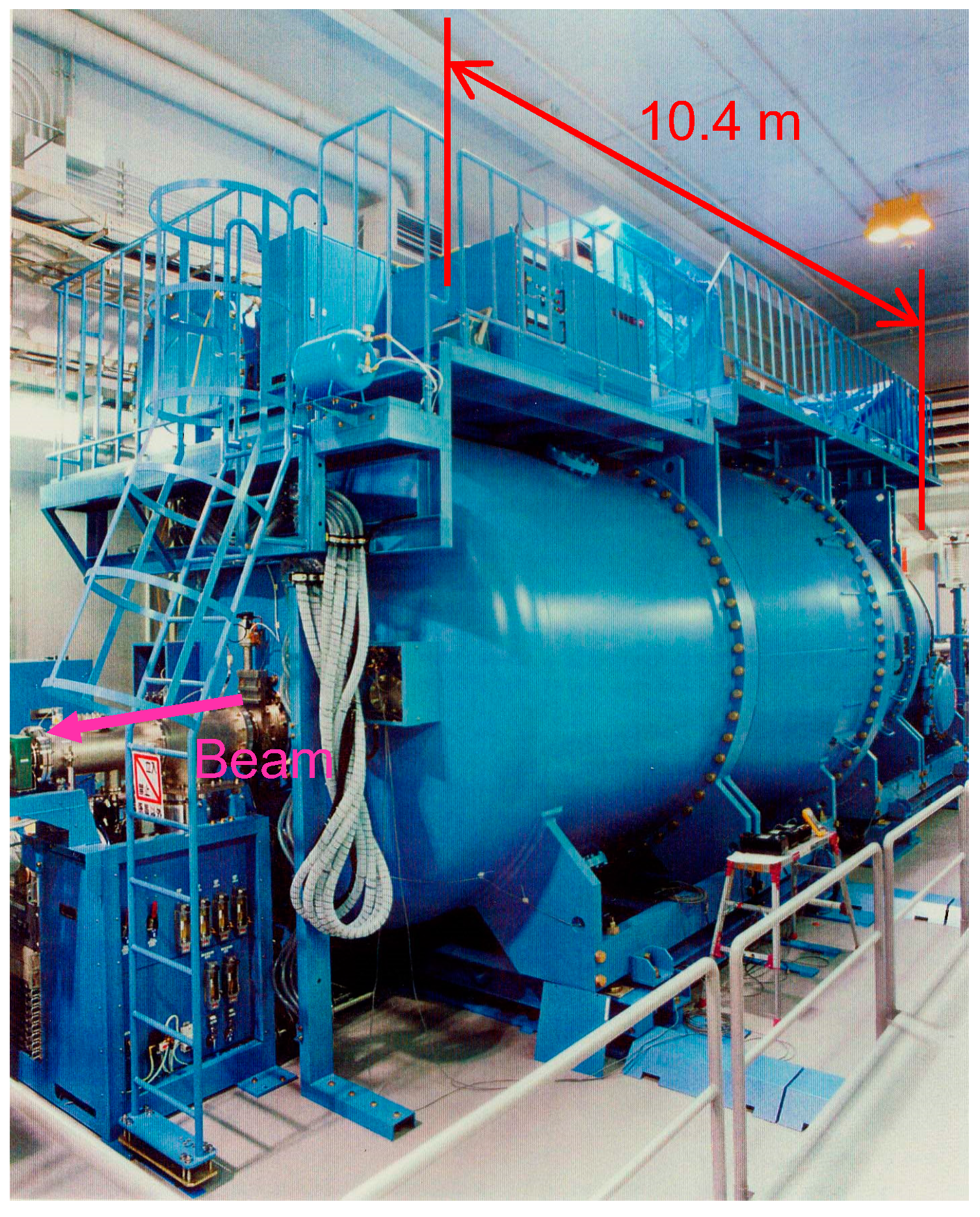

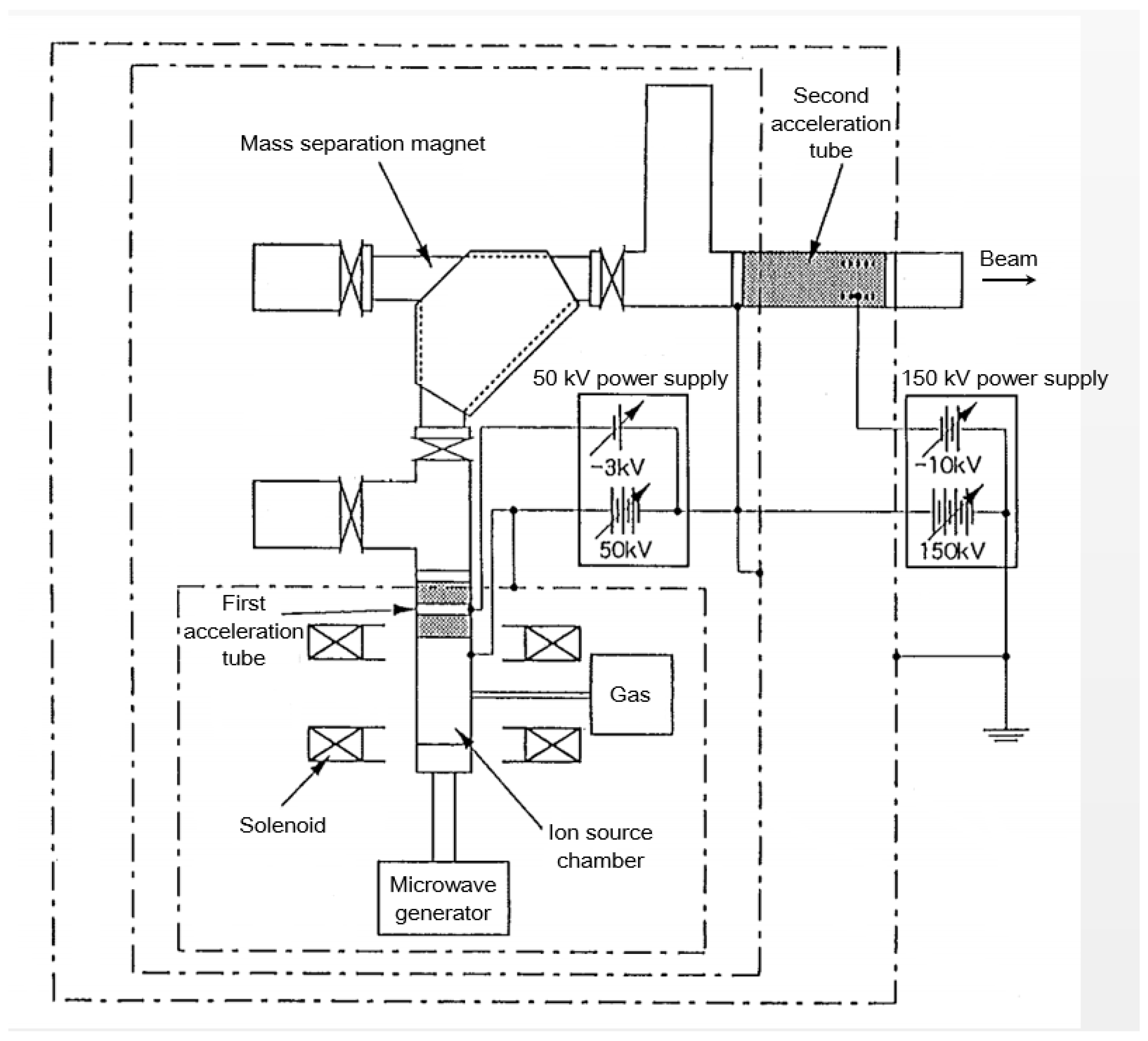
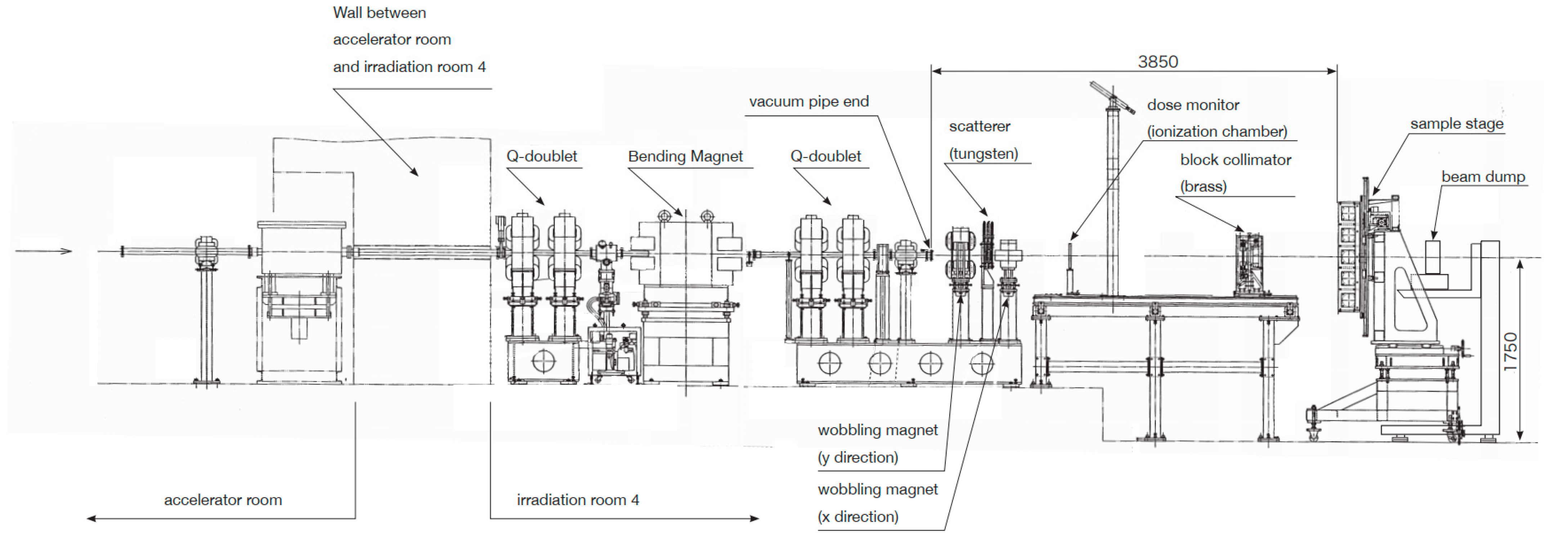
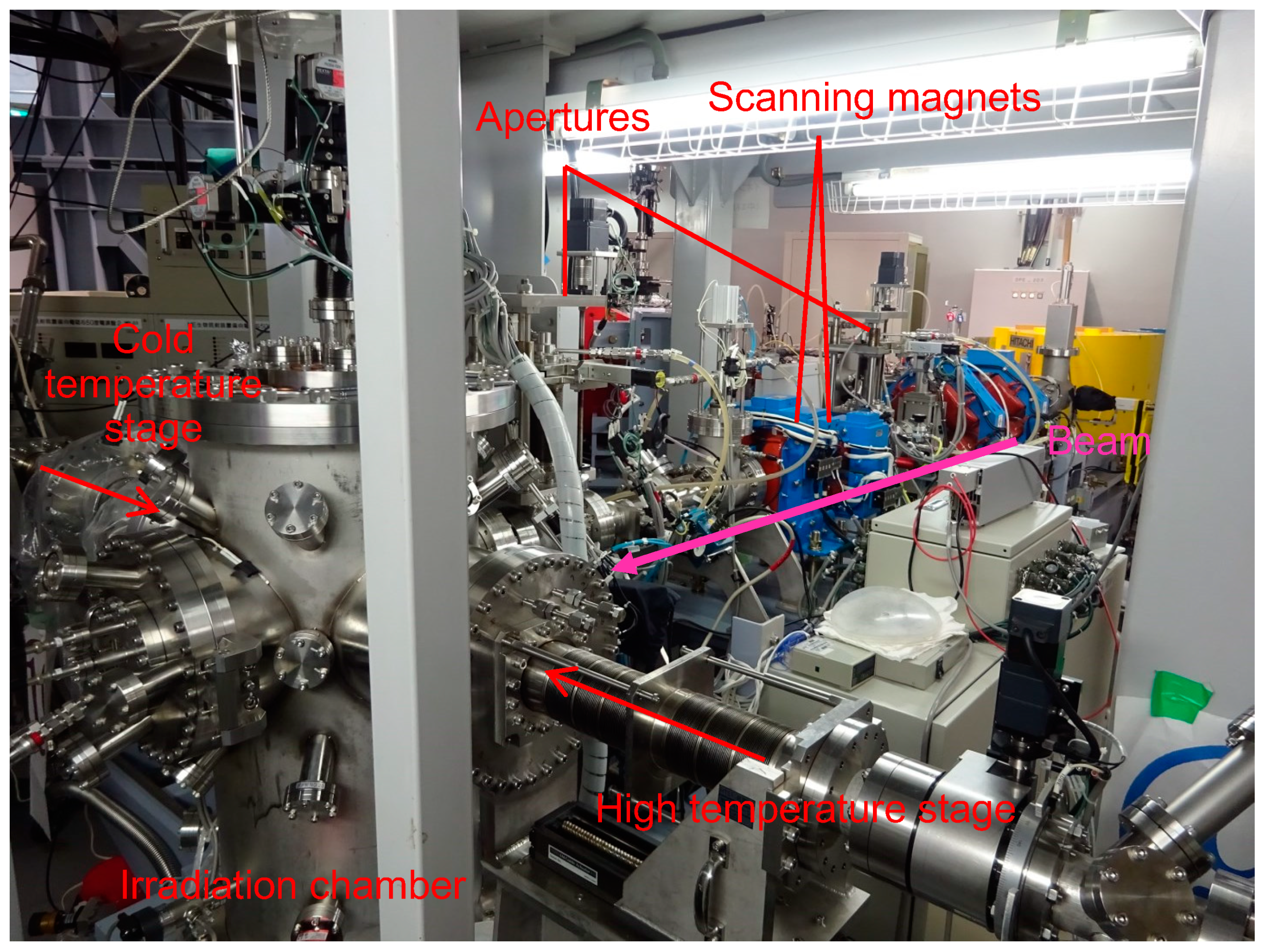
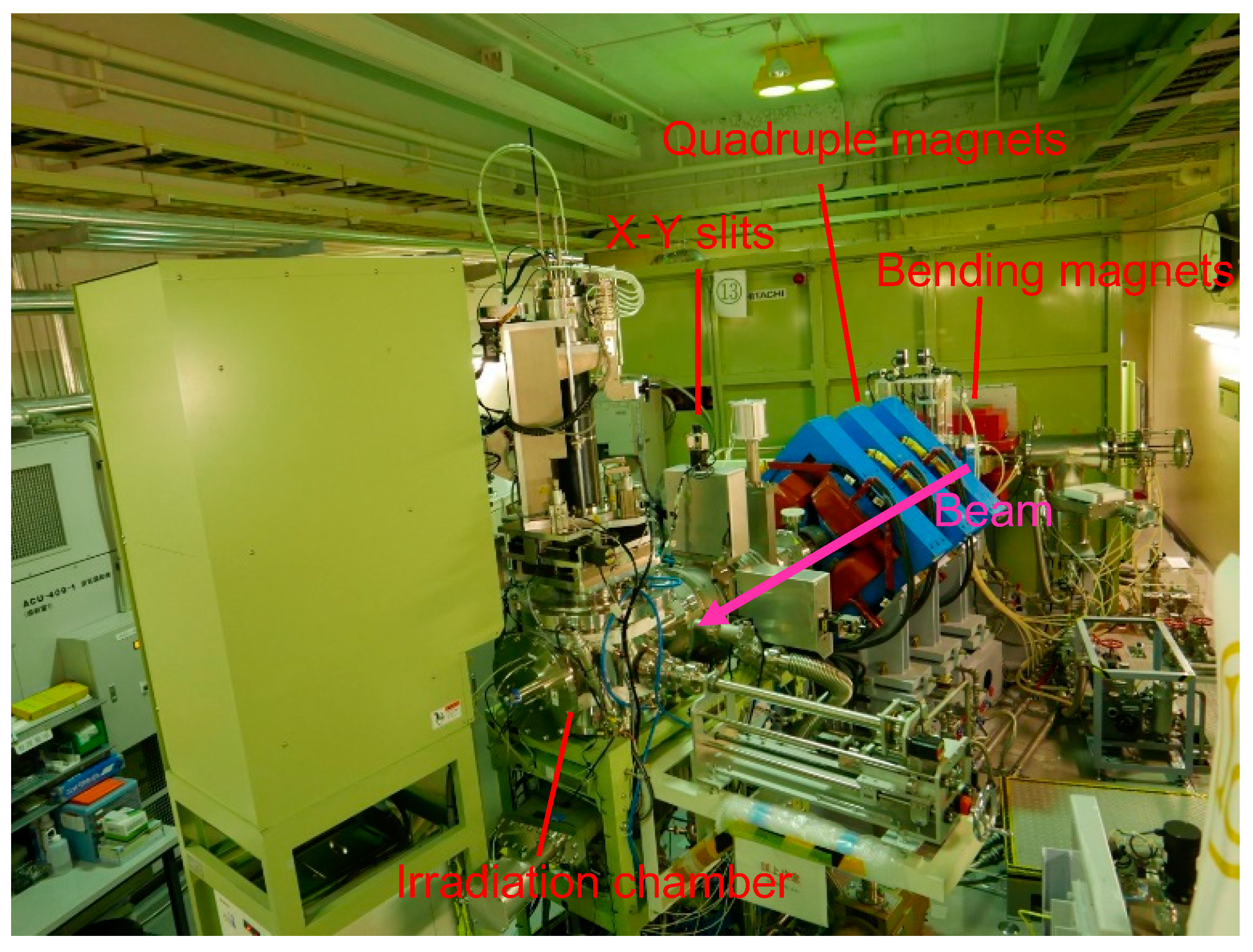

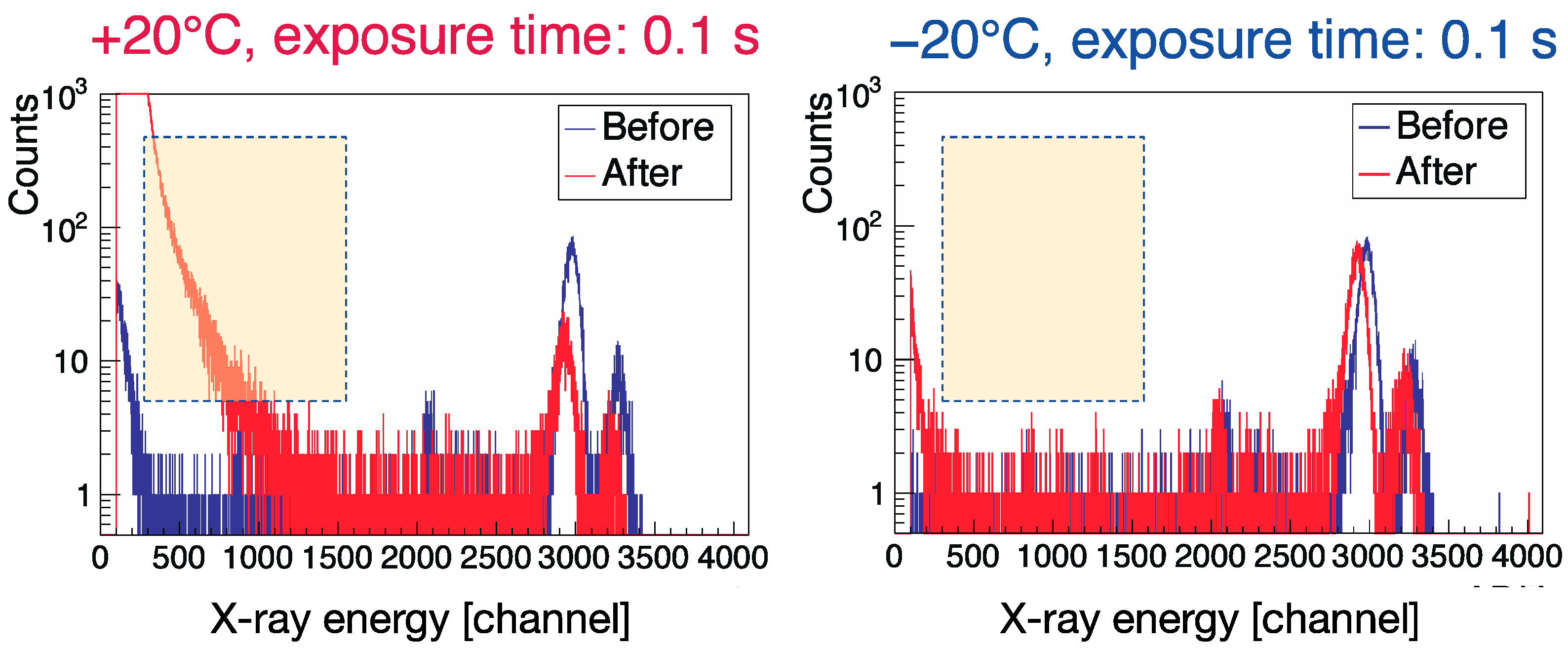
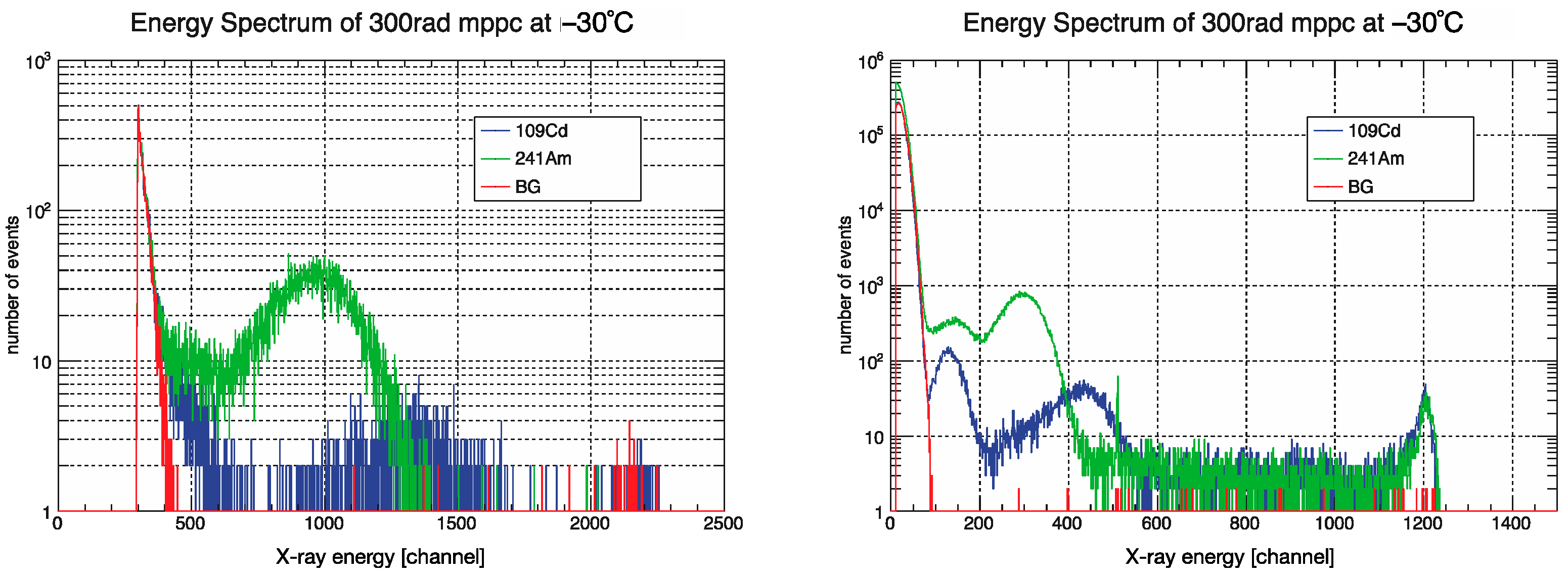
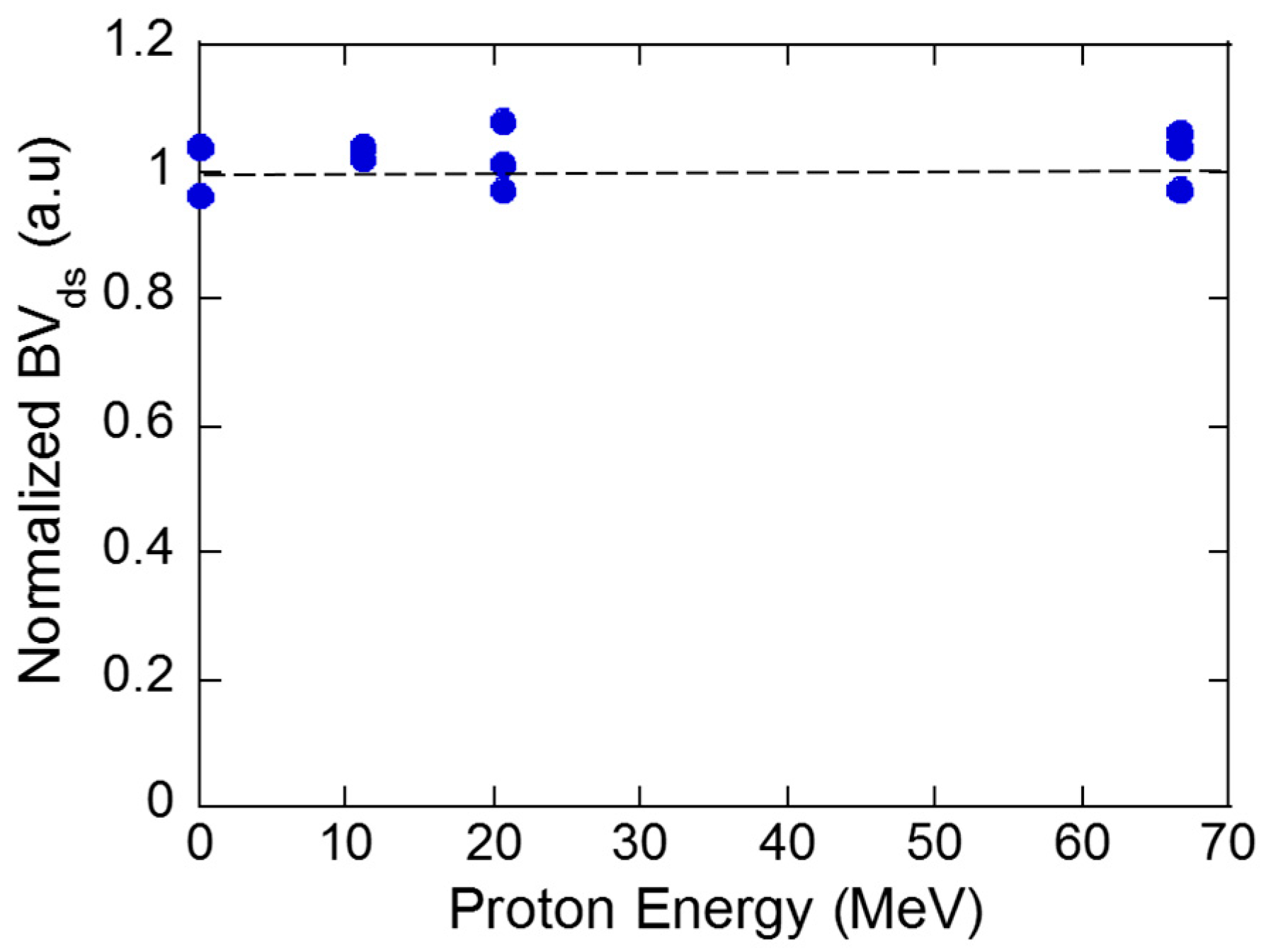



| Categories | Specifications |
|---|---|
| Generation of high voltage | Cascade of voltage doubler rectifiers (Schenkel Rectifier) |
| Max terminal voltage | 5 MV |
| Max conveyer current | 1 mA |
| Voltage ripple | 0.4 kVpp @ 5 MV |
| Insulation gas | SF6 0.6 MPa gauge |
| Accelerator tube | Glass–metal organic bonding |
| Charge exchange | Ar–gas stripper, recirculation and concentrationby 4 TMP (50L/s/pump) |
| Injected ion ME (mass·energy value) | 6 MeV·amu |
| Categories | Specifications | ||
|---|---|---|---|
| Incident energy | H+ | 10 MeV | (Bρ = 0.46 Tm) |
| Heavy Ions | 2.08 MeV/u | (Bρ = 0.42 Tm) | |
| Acceleration energy | H+ | 200 MeV | (Bρ = 2.15 Tm) |
| Heavy Ions | 55 MeV/u | (Bρ = 2.15 Tm) | |
| Acceleration period | 0.5 Hz | ||
| Lattice | QF-BM-QD-BM | ||
| Injection | Multi-turn injection | ||
| RF cavity | Asynchronous RF cavity | ||
| Extraction | Resonance-RF knockout | ||
| Superperiodicity | 4 | ||
| Circumference | 33.2 m | ||
| Tune | Horizontal νx | 1.75 | |
| Vertical νy | 0.85 | ||
| Bending magnet | Bending angle | 45 deg | |
| Maximum field | 1.12 T | ||
| Radius | 1.91 m | ||
| Momentum compaction | 0.31 | ||
| Natural chromaticity | x | −0.34 | |
| y | −0.36 | ||
| Categories | Specifications |
|---|---|
| Beam elements | H, H2, He, Ne, N, N2, O, O2, Ar, CO, etc. |
| Beam energy | 10 to 200 keV |
| Typical beam current | <1 mA |
| Beam current density | ~20 µA/cm2 |
| Irradiation area | Maximum 100 × 100 mm2 |
| Target stage | Heating stage 3, Cooling stage 2 |
| Heating stage control | Room temperature to 1000 °C |
| Accelerator | Target | Purpose | Effect | Ion and Energy |
|---|---|---|---|---|
| Synchrotron | Si-CMOS image sensor | X-ray detector | TID/DDD | p, 100 MeV |
| ASIC | Signal processing for X-ray detector | TID | p, 90 MeV | |
| Silicon Photomultiplier | X-ray detector | SEE | p, 200 MeV | |
| Electric substrate | Microcomputer | SEE | p, 20–200 MeV | |
| LaBr3(Ce) scintillator | X-ray detector | Radioactivation | p, 20–140 MeV | |
| AlGaN/GaN HEMT | Power device | TID | p, 11.1–66.8 MeV | |
| Tandem | AlGaN/GaN HEMT | Power device | DDD | p, 2 MeV |
| CCD | Optical imager | TID | p, 8 MeV | |
| Ion-Implanter | InGap/GaAs/Ge solar cell | Solar cell | DDD | p, 50–150 keV |
| Perovskite solar cell | Solar cell | DDD | p, 50 keV |
Publisher’s Note: MDPI stays neutral with regard to jurisdictional claims in published maps and institutional affiliations. |
© 2021 by the authors. Licensee MDPI, Basel, Switzerland. This article is an open access article distributed under the terms and conditions of the Creative Commons Attribution (CC BY) license (https://creativecommons.org/licenses/by/4.0/).
Share and Cite
Hatori, S.; Ishigami, R.; Kume, K.; Suzuki, K. Ion Accelerator Facility of the Wakasa Wan Energy Research Center for the Study of Irradiation Effects on Space Electronics. Quantum Beam Sci. 2021, 5, 14. https://doi.org/10.3390/qubs5020014
Hatori S, Ishigami R, Kume K, Suzuki K. Ion Accelerator Facility of the Wakasa Wan Energy Research Center for the Study of Irradiation Effects on Space Electronics. Quantum Beam Science. 2021; 5(2):14. https://doi.org/10.3390/qubs5020014
Chicago/Turabian StyleHatori, Satoshi, Ryoya Ishigami, Kyo Kume, and Kohtaku Suzuki. 2021. "Ion Accelerator Facility of the Wakasa Wan Energy Research Center for the Study of Irradiation Effects on Space Electronics" Quantum Beam Science 5, no. 2: 14. https://doi.org/10.3390/qubs5020014
APA StyleHatori, S., Ishigami, R., Kume, K., & Suzuki, K. (2021). Ion Accelerator Facility of the Wakasa Wan Energy Research Center for the Study of Irradiation Effects on Space Electronics. Quantum Beam Science, 5(2), 14. https://doi.org/10.3390/qubs5020014






